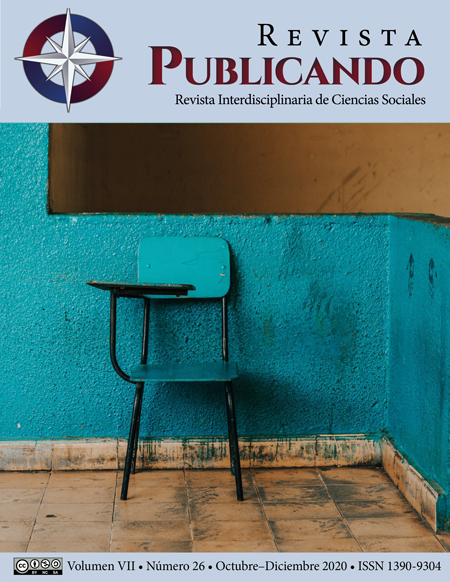Abstract
Due to preventable causes related to pregnancy and childbirth, about 1000 women die every day in the world, bringing with it irreversible psychosocial consequences in the family and the community, a phenomenon that is exacerbated in developing countries; Under this premise, the following objective was set: To determine the adherence to prenatal control of pregnant women who were registered by health professionals at the August 16 Health Post belonging to the District Office 14D02 Huamboya-Pablo Sexto-Palora-Salud. A retrospective, descriptive, analytical cross-sectional study was carried out in which 63 pregnant women between the ages of 12 and 39 years were included. The collection and statistical analysis of the results showed the predominance of pregnant women between 20 and 24 years of age; 95.2% of the users do not have social security or peasant insurance, most of them belong to the communities of Chai, Yavintza and Santa Inés; only 34.9% of the pregnant women were recorded in the prenatal control records. The main social determinants of health that influence adherence to prenatal care are: age, beliefs, customs, geographical accessibility, the region's climate and gender inequality, a situation that worries health authorities who can identify and intervene in advance in view of the risks related to pregnancy to achieve not only an adequate pregnancy but also to avoid complications in childbirth that leave sequelae for the mother, her child and the community.
References
Aguilera, S., & Soothill, P. (2014). Control Prenatal. Revista Médica Clínica Las Condes, 25(6), 880–886. https://doi.org/10.1016/s0716-8640(14)70634-0
Angel, E., & Gaitan, H. (2011). Infección puerperal y postaborto. Obstetricia Integral Siglo XXI, 1–26. Retrieved from http://www.bdigital.unal.edu.co/2795/
Beuermann, D. W., Garcia, P., Perez Lu, J., Anta, R., Maffioli, A., & Rodrigo, M. F. (2020). Information and Communication Technologies, Prenatal Care Services, and Neonatal Health. Journal of Economics, Race, and Policy, 3(1), 41–59. https://doi.org/10.1007/s41996-019-00038-w
Castro, M. F. (2014). Factores Predisponentes De La Infección Puerperal Post Cesárea En El Hospital Gineco - Obstétrico Enrique Carlos Sotomayor De Septiembre 2012- Febrero 2013. Tesis, (Proyecto de Factibilidad Técnica, Económica y Financiera del Cultivo de Ostra del Pacíficoen la Parroquia Manglaralto, Cantón Santa Elena, Provincia de Santa Elena), 121.
Domínguez, E., Flores, C., & Pacherres, S. (2017). Modelo de atención integral de salud familiar, comunitario e intercultural. Dominio de Las Ciencias, 3(2), 921–935.
FAO. (2017). Mujeres rurales: luchando por lograr impactos transformadores de género. Foro Global Sobre Seguridad Alimentaria y Nutrición, 16. Retrieved from http://www.fao.org/3/I8222ES/i8222es.pdf
Garcia, M. I. B., Zuñiga, D. O. L., Lanchi, V. G., Zuñiga, J. A., & Burgos, Á. D. (2019). La Tecnología y el Compromiso Individual del Autocuidado Sobre Riesgos para Desarrollar Diabetes en Adultos Mayores. RISTI - Revista Iberica de Sistemas e Tecnologias de Informacao, 2019(E18), 181–190. Retrieved from https://www.researchgate.net/profile/Felipe_Semaan/publication/333194829_Nanomateriais_e_dispositivos_para_a_area_de_Defesa/links/5ce13a86a6fdccc9ddbc7f27/Nanomateriais-e-dispositivos-para-a-area-de-Defesa.pdf#page=197
Gonzalés Ramos, R. M., Hechavarría Puente, G., Batista González, N. M., & Cueto Salas, A. (2017). Los determinantes sociales y su relación con la salud general y bucal de los adultos mayores. Revista Cubana de Estomatologia, 54(1), 60–71.
Guillot, C. C., & Viamonte, K. R. (2016). La Atención Primaria de Salud y la Enfermería Primary Health Care and Nursing. UNIANDES EPISTEME: Revista de Ciencia, Tecnología e Innovación, 3(3), 1–18. Retrieved from http://186.46.158.26/ojs/index.php/EPISTEME/article/view/273/222
INEC (2016). Instituto Nacional de Estadística y Censos. Quito: INEC.
Miranda, C., & Castillo, I. (2016). Factores de necesidad asociados al uso adecuado del control prenatal. Revista CUIDARTE, 7(2), 1345. https://doi.org/10.15649/cuidarte.v7i2.340
MSP (2012). Manual del Modelo de Atención Integral de Salud - MAIS. Ministerio de Salud Pública Del Ecuador. Retrieved from http://instituciones.msp.gob.ec/somossalud/images/documentos/guia/Manual_MAIS-MSP12.12.12.pdf
OMS (2014). Organización Mundial de la Salud. Centro de Prensa. Mortalidad materna. Nota descriptiva N° 348. Retrieved from http://www.who.int/mediacentre/factsheets/fs348/es/
OMS (2018). Recomendaciones de la OMS sobre atención prenatal para una experiencia positiva del embarazo. Retrieved from https://www.who.int/reproductivehealth/publications/maternal_perinatal_health/anc-positive-pregnancy-experience/es/
Pérez, A. ortiz. (2017). Tesis doctoral. Learning, Culture and Social Interaction, 2(1), 45–55. https://doi.org/10.1174/021435502753511268
Prinz, D., Chernew, M. E., Cutler, D. M., & Frakt, A. (2018). Documento de trabajo de NBER No. w24865, disponible en SSRN: Retrieved from https://ssrn.com/abstract=3222412
Roldán, J. C., Acuña, C., & Ríos, P. (2017). Método de búsqueda activa comunitaria para la captación de gestantes y puérperas en Ecuador. Revista Panamericana de Salud Publica/Pan American Journal of Public Health, 41(3), 1–6. https://doi.org/10.26633/rpsp.2017.53
Shuguli, N., & Buñay, M. (2017). Factores que influyen a la falta de control prenatal en el centro de salud de Malchingui del cantón Cayambe en el periodo de noviembre 2016 a febrero 2017. Retrieved from http://www.dspace.uce.edu.ec/bitstream/25000/10121/1/T-UCE-0006-122.pdf
SII. (2012). Aportes para la operativización del Modelo de Atención Integral De Salud basado en familia y comunidad en el primer nivel. Proyecto Multipaís Bolivia, Guatemala y Perú, 9(163), 112.

This work is licensed under a Creative Commons Attribution-NonCommercial-ShareAlike 4.0 International License.
Copyright (c) 2020 Esteban Armando Piña Calle


